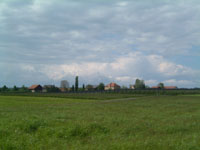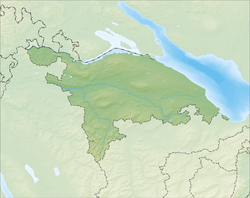Hefenhofen
| Hefenhofen | ||
|---|---|---|
 |
||
|
||
| Coordinates: 47°33′N 9°18′E / 47.550°N 9.300°ECoordinates: 47°33′N 9°18′E / 47.550°N 9.300°E | ||
| Country | Switzerland | |
| Canton | Thurgau | |
| District | Arbon | |
| Area | ||
| • Total | 6.05 km2 (2.34 sq mi) | |
| Elevation | 451 m (1,480 ft) | |
| Population (Dec 2015) | ||
| • Total | 1,229 | |
| • Density | 200/km2 (530/sq mi) | |
| Postal code | 8580 | |
| SFOS number | 4416 | |
| Surrounded by | Amriswil, Dozwil, Kesswil, Romanshorn, Salmsach, Sommeri, Uttwil | |
| Website |
www SFSO statistics |
|
Hefenhofen is a municipality in the district of Arbon in the canton of Thurgau in Switzerland.
Hefenhofen is first mentioned in 817 as Hebinhova. Hefenhofen was a fief of the Abbey of Saint Gall and until the 17th Century it was part of the Bailiwick of Hagenwil. In 1600, the low court of Hefenhofen was formed, which included Auenhofen, Hatswil, Moos and Tonhub. In 1644 the Lords of Bernhausen divided their lands, which included Hefenhofen. From 1644 until 1798 a number of different individuals owned the village.
Since the Protestant Reformation Hefenhofen had belonged to the Reformed parish of Sommeri. In 1870, the political and geographic municipalities were merged into the combined municipality of Hefenhofen.
In the 19th Century the major economic activities included fruit production and weaving. Towards the end of the 19th Century, this transitioned to cattle and dairy farming. In 1900 Hefenhofen included several farms and silk embroidery industry. The only heavy industry in Hefenhofen until 1950, was the Stutz construction business founded in 1877 (in 2003 it had approximately 260 employees) and the Hatswil mill. Opened in 1975, the municipal solid waste incinerator of the Oberthurgau region, closed their doors in 1996.
Hefenhofen has an area, as of 2009[update], of 6.05 square kilometers (2.34 sq mi). Of this area, 4.15 km2 (1.60 sq mi) or 68.6% is used for agricultural purposes, while 1.23 km2 (0.47 sq mi) or 20.3% is forested. Of the rest of the land, 0.76 km2 (0.29 sq mi) or 12.6% is settled (buildings or roads).
Of the built up area, industrial buildings made up 6.1% of the total area while housing and buildings made up 1.2% and transportation infrastructure made up 1.2%. while parks, green belts and sports fields made up 4.1%. Out of the forested land, 17.9% of the total land area is heavily forested and 2.5% is covered with orchards or small clusters of trees. Of the agricultural land, 50.9% is used for growing crops, while 17.7% is used for orchards or vine crops.
...
Wikipedia




